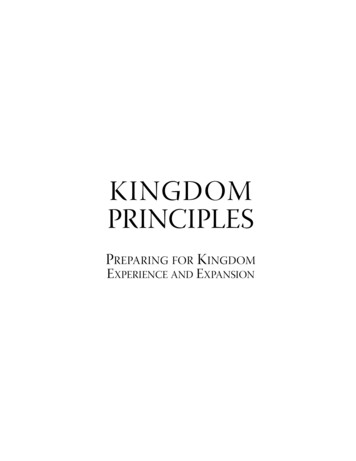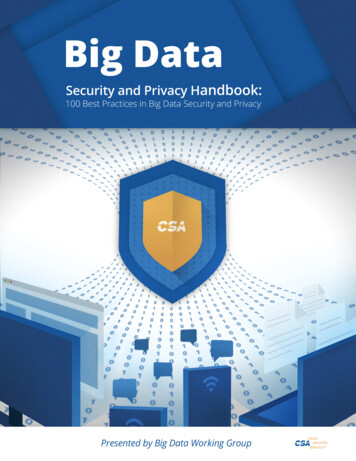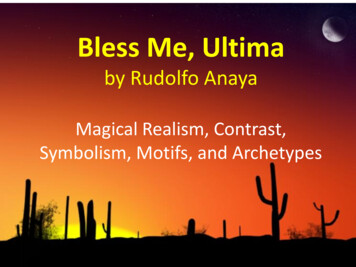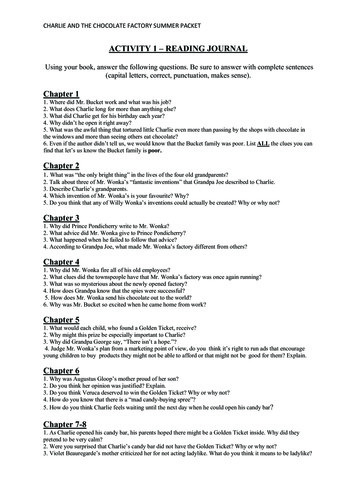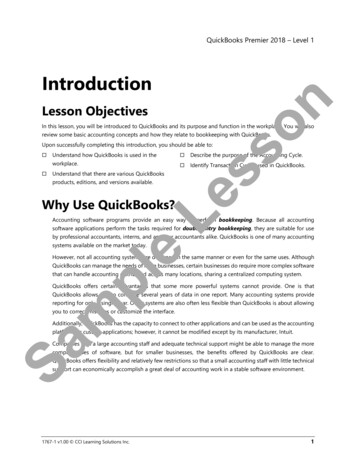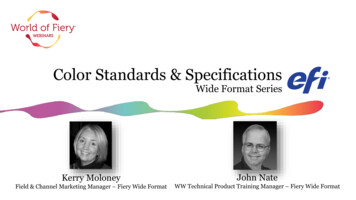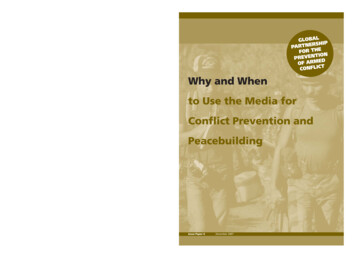
Transcription
OmslagRapport6Proef13-03-200816:18Pagina 1Why and Whento Use the Media forConflict Prevention andPeacebuildingThe Global Partnership for the Prevention of Armed Conflictc/o European Centre for Conflict PreventionLaan van Meerdervoort 702517 AN Den HaagThe NetherlandsTel.: 31 70 3110970Fax: 31 70 sue Paper 6December 2007
Vladimir Bratic andLisa SchirchWhy and Whento Use the Media forConflict Prevention andPeacebuildingIssue Paper 6December 2007
European Centre for Conflict Prevention/Global Secretariat of theGlobal Partnership for the Prevention of Armed ConflictLaan van Meerdervoort 702517 AN Den HaagThe NetherlandsTel.: 31 70 3110970Fax: 31 70 3600194info@conflict-prevention.netwww.gppac.net 2007 European Centre for Conflict PreventionAll rights reserved. No part of this publication may be reproduced inany way without full attribution.Production: Bureau M&O, AmsterdamLayout: MMS Grafisch Werk, AmsterdamPrinted by Haasbeek, Alphen a/d RijnCover photo: Witness for Peace volunteer Doug Schirch interviewsNicaraguan Contra forces in 1988 after their kidnapping a fellowvolunteer. Photo by Paul Dix
TABLE OF CONTENTSABOUT THIS ISSUE PAPER 5INTRODUCTION 71. THE MEDIA’S ORIENTATION TOWARD CONFLICT 82. FUNCTIONS OF THE MEDIA IN CONFLICT PREVENTION AND PEACEBUILDING 93. THE TRANSFORMATIVE GOALS OF CONFLICT PREVENTION AND PEACEBUILDING 124. HOW DOES CHANGE HAPPEN? 145. STAGES OF CHANGE 166. WHY DO PEOPLE CHANGE? 217. THE IMPACT OF TRAUMA AND CONFLICT ON COGNITION 238. THE MEDIA AND CREATING CRITICAL MASS FOR PEACE 24CONCLUSION 26BIBLIOGRAPHY 27THE GLOBAL PARTNERSHIP FOR THE PREVENTION OF ARMED CONFLICT 29Why and When to Use the Media for Conflict Prevention and Peacebuilding
ABOUT THIS ISSUE PAPERThe Global Partnership for the Prevention of ArmedConflict (GPPAC) is a world-wide civil society-lednetwork that calls for a fundamental change in dealingwith violent conflict: a shift from reaction to prevention.One of the key priorities for the network is awarenessraising: GPPAC aims to reach a global consensus onpeace building and conflict prevention, and believes thecelebration of the UN International Day of Peace on the21st of September on a global scale to be a greatopportunity to reach this goal.Its efforts are, however, in their infancy and synergybetween individual actions by GPPAC members is stillsomewhat lacking. In general it can be said that theconflict prevention community has still to learn how tospeak with a collective voice to the media and thepublic. ‘Selling’ conflict prevention comes with certainchallenges and is at risk of being perceived asimpractical idealism in the face of concretepolicymaking.The following paper - the sixth in a series of studies intoissues related to conflict prevention and peacebuilding therefore sets out how a civil society organizationworking in the field of conflict prevention andpeacebuilding should deal and interact with the media.As civil society organizations working on conflictprevention and peacebuilding we have a lot to tell themedia, but we are not necessarily always effective ingetting our message across. The paper maps what thedifficulties are for civil society talking to the media, andwhat skills or knowledge they should acquire toovercome these obstacles.Why and When to Use the Media for Conflict Prevention and PeacebuildingThe paper was written by Lisa Schirch and VladimirBratic.Lisa Schirch is a professor of peacebuilding at EasternMennonite University. A former Fulbright Fellow, shehas worked with communities and government leadersto build peace and security in Lebanon, Iraq, Taiwan,Ghana, Kenya, Brazil, and other countries. Shespecializes in building peace and security throughdevelopment and diplomacy and is the director of the3D Security Initiative (www.3Dsecurity.org). She is theauthor of five books on peacebuilding and conflictprevention; Dialogue on Difficult Subjects, Ritual andSymbol in Peacebuilding, Strategic Peacebuilding,Civilian Peacekeeping: Reducing Violence and MakingSpace for Democracy, and Women in PeacebuildingTraining Manual.Vladimir Bratic is an Assistant Professor ofCommunication Studies at Hollins University. He isoriginally from Sarajevo, Bosnia and Herzegovinawhere he initiated his research on the role of the mediain conflict and peace. He primarily specializes ininternational/intercultural communication, developmentcommunication, political communication andpersuasion. He has published articles and teaches abouthow media can help promote peaceful transformation ofviolent conflict across the world.As part of the GPPAC Awareness Raising program, thepaper was created with the financial support of theDutch Ministry of Foreign Affairs. If you have anyquestions related to the paper or the broader AwarenessRaising program, please contact the European Centrefor Conflict Prevention, the Global Secretariat ofGPPAC through Charlotte Crockett(c.crockett@conflict-prevention.net) or Marte Hellema(m.hellema@conflict-prevention.net).5
INTRODUCTIONHistory has shown that the media can incite peopletoward violence. Hitler used the media to create anentire worldview of hatred for Jews, homosexuals, andother minority groups. Rwanda’s radio RTLM urgedlisteners to pick up machetes and take to the streets tokill what they called ‘the cockroaches.’ Broadcasters inthe Balkans polarized local communities to the pointwhere violence became an acceptable tool foraddressing grievances. The media’s impact on theescalation of conflict is more widely recognized than themedia’s impact on peacebuilding.given its powerful impact on conflict. However, thissimple relationship must not be taken for granted andshould be critically examined in order to mosteffectively use the media for conflict prevention andpeacebuilding. There are ways the media can assistpeacebuilding. The Global Partnership for thePrevention of Conflict’s Awareness Raising Toolkit (thisdocument can be downloaded from www.gppac.net andwww.peoplebuildingpeace.org) details, amongst otherthings, how to use the media. Knowing why and when touse the media for conflict prevention and peacebuildingis the focus of this issue paper.Yet it is not uncommon to hear experts pronounce thatthe media’s impact on peacebuilding must be significantWhy and When to Use the Media for Conflict Prevention and Peacebuilding7
1.THE MEDIA’S ORIENTATION TOWARDCONFLICTThe media shape what we see and hear about conflict.The perspectives of those who run the media shapestories that are covered. Journalists have opinions andbeliefs based on their experiences. Media owners haveeconomic interests; they want to sell their stories andprograms to a public who will buy their newspapers orwatch their programs. Increasing corporate control overmedia in some countries also plays a role in controllingthe types of stories that get covered and the way storiesget framed.Media owners and professionals decide what they thinkthe public or some target audience wants to see andhear. A common journalist principle is this: “If it bleeds,it leads.” That means violent conflict will be headlinenews, not news of cross-cultural dialogue andunderstanding. The media mostly covers conflict, notpeacebuilding. This tendency to cover conflict andviolence distorts reality and leads many people to thinkthat conflict is pervasive and peace is abnormal.Several studies confirm that the impact of the media onconflict is greater than the impact of the media onconflict prevention and peacebuilding.1 Peacejournalism scholar Gadi Wolfsfeld notes there is a“fundamental contradiction between the nature of apeace process and news values, the media often play adestructive role in attempts at making peace.”2 Thosewho run the media tend to favor four values: immediacy,drama, simplicity and ethnocentrism. These valuesThe media use the four values identified in the chart todecide what to cover as news, and what makes forentertainment. While many media professionals holdthese values, they are likely to be in direct relation to thevalues of the public at large. The media are, in fact,running a business and as such, need to create a‘product’ that will sell to customers who share thesevalues.It is important for conflict prevention and peacebuildingpractitioners to understand these values and thedynamics of media decision-making on covering‘peace’ news and entertainment. However, it does notpreclude peace practitioners from utilizing the media topromote their own values.Indeed, the media can play very positive roles in conflictprevention and peacebuilding.1 Wolfsfeld G. (2004) Media and the path to peace. New York: CambridgeUniversity Press.Hamelink. C. J. (2002) Communication May Not Build Peace, But It CanCertainly Contribute To War. Media Development 2.Gowing, N. (1997). Media coverage: Help or hindrance in conflictprevention. Retrieved January 21, 2002 from fr.htm2 Gadi Wolfsfeld. Ibid, p. 15.Media FocusNo Media FocusImmediacySpecific actions and eventsLong-term processes and policies (asin ongoing peace processes,dialogue, or mediation)DramaViolence, crisis or conflictExtremist behaviorsOutrageous actsClear cut opinions, images, majorpersonalities, two-sided conflictsCalm, controlled, moderate peoplegetting along with each other (suchas those participating in a dialogue)Complex opinions or explanations,institutions, root causes, multi-sidedconflictsOur beliefs, myths and symbolsOur sufferingThe brutality of some ‘Other’Their beliefs, myths, and symbolsTheir sufferingOur brutality to ‘Them’SimplicityEthnocentrism8make it difficult to use the media for peace. The chartbelow, adapted from Wolfsfeld’s work, illustrates thetendency for these values to favor violence rather thanpeace.Why and When to Use the Media for Conflict Prevention and Peacebuilding
2.FUNCTIONS OF THE MEDIA IN CONFLICTPREVENTION AND PEACEBUILDINGThe media play a wide range of roles in our lives. Someof these roles are constructive and some are destructive.Recognizing the diversity within media professionals isa first step in critically analyzing how best to use themedia to support conflict prevention and peacebuilding.Media as Information Provider and InterpreterThe media provide people with important informationabout their environment (e.g. political, cultural, socialissues) and respond to more imminent problems (weather,traffic, natural catastrophes, etc.). At least in part, peoplemake decisions about whether to dress for warm or cold,choose political leaders to vote for in elections, and judgeother groups in society based on the media.The media interpret events beyond our physical realmand help us make sense of them. With the improvementof technologies and the advancement of new media suchas the internet, media plays an increasingly moreprominent role in our daily communication andentertainment.For example, the Otpor Movement, developed in 1998by Serbian students, responded to new restrictions onacademic and media freedom with a highlyunconventional movement called Otpor (‘resistance’ inSerbian). Otpor developed their own grassroots mediacampaign to provide information and inspiration to allwho resisted the Milosevic government.3Media as WatchdogThe media sometimes acts as a third party ‘watchdog’who provide feedback to the public on local problems.Media can bring hidden stories out into the public.Investigative reports can surface public problems. Forexample, a US journalist uncovered and exposed aveteran’s hospital that was dilapidated, rat-infested, anduncaring.4 This highlighted a problem of how US soldiersare treated before and after their time in the US military.In Sierra Leone, a video depicting the serious impactsand extent of sexual violence has instigated discussionon the impact of the civil war in that country. The film,titled Operation Fine Girl: Rape Used as a Weapon ofWar in Sierra, was produced by human rights activistsWhy and When to Use the Media for Conflict Prevention and PeacebuildingThe Otpor movement attracted a lot of attention with itsgraffiti and sticker campaigns. ‘Gotov je’ – ‘he’s finished’ – isplastered across a Milosevic election poster.with the international non-governmental organizationWITNESS.5 The film demonstrates how mediaproductions can play an important complementary rolealongside other post conflict reconciliation processes topromote awareness of critical social issues and bringthem into the public arena so they can be addressed.Media as GatekeeperThe media can also act as a gatekeeper who setsagendas, filters issues and tries to maintain a balance ofviews. Media like to portray themselves as ‘balancedand fair,’ even when they privately seek to promote aparticular ideological set of ideas and limit the public’sexposure to a wide array of information.In 2006, a cartoonist in Denmark created internationalconflict with his message about Islam. The globaltensions prompted extensive analysis on how and whenmedia professionals should act as a gatekeeper toprevent certain expressions that could be deemedhumiliating or offensive to some groups.3 Milja Jovanovic. “Rage Against the Regime: The Otpor Movement inSerbia.” In Van Tongeren, Paul, Malin Brenk, Marte hellema and JulietteVerhoeven (eds.) People Building Peace II: Successful Stories of CivilSociety. Boulder, US: Lynne Rienner Publishers, 2005.4 Dana Priest and Anne Hull. February 18, 2007. “Soldiers Face Neglect,Frustration At Army’s Top Medical Facility.” Washington Post. February18, 2007. P. A019
2. FUNCTIONS OF THE MEDIA IN CONFLICT PREVENTION AND PEACEBUILDINGFor example, an American television show Nightlineregularly invites two or more people from different sidesof a public policy issue to be on the show and dialoguewith each other. The host, Ted Koppel, makes a point oftrying to find common ground between the two sides.Media as Peace PromotorMedia events can be used at the beginning ofnegotiations to build confidence, facilitate negotiationsor break diplomatic deadlocks to create a climateconducive to negotiation.A girl portrayed in the WITNESS documentary Operation FineGirlMedia as PolicymakerThe media has influence on policymakers, particularlyas they think about how to prevent and respond toviolent conflict. The media is also a tool ofpolicymakers to get across their message. Sometheorists even claim that CNN has taken overpolicymaking - at least in humanitarian disastersituations. Images on CNN of genocide, famine, andviolence force policymakers to intervene militarily tostop death, even if they do not think it is in the bestinterest of their country to adopt this policy. In Bosnia,for example, the media played a very important role inmotivating the public to press their policymakers tointervene to stop the aggression.6Media as DiplomatSometimes the media is used to cover diplomaticinitiatives and send messages back and forth betweensides of a conflict. While policymakers usually prefersecret negotiations, sometimes there are no directchannels of communication. If one side wants to testreactions to a negotiation proposal, they may sendsignals and messages to other groups through the media.At times, the news media will invite leaders of opposinggroups or nations onto a TV or radio program to talkwith each other. The media may help to create bridgesamong enemies and build confidence needed to opennegotiations.710Media events such as press releases, rock concerts, orradio programs can celebrate peace agreements andnegotiations. The media events may help to promote andmobilize public support for agreements.For example, in Burundi, Studio Ijambo is attempting toharness the power of radio for constructive purposes.Beginning in 1995, Search for Common Ground set upStudio Ijambo with a team of twenty Hutu and Tutsijournalists to promote dialogue, peace, andreconciliation. Studio Ijambo produces approximatelyone hundred radio programs per month to create asteady campaign to promote peace.8Media as Bridge BuilderThe media can promote positive relationships betweengroups, particularly in conflicts over national, ethnic,religious identity. The media can lessen polarizationbetween groups in the following ways: Showing the other in a similar light to selfIraqi news media that emphasize how both Shia andSunni suffer from violence help build a bridge ofcommon empathy.5. Gregory, Sam. 2005. “Operation Fine Girl Exposes Sexual ViolenceWitness in Sierra Leone.” In Van Tongeren, Paul, Malin Brenk, MarteHellema and Juliette Verhoeven (eds.) People Building Peace II:Successful Stories of Civil Society. Boulder, USA: Lynne RiennerPublishers6. Gilboa, Eytan. 2002. Media and Conflict: Framing Issues, Making Policy,Shaping Opinions. Ardsley, NY, USA: Transnational Publishers Inc.7 Ibid.8 Gilboa, Eytan. 2002. Media and Conflict: Framing Issues, Making Policy,Shaping Opinions. Ardsley, NY, USA: Transnational Publishers Inc.Why and When to Use the Media for Conflict Prevention and Peacebuilding
2. FUNCTIONS OF THE MEDIA IN CONFLICT PREVENTION AND PEACEBUILDINGJournalists at a press conference during GPPAC‚s 2006 International Steering Group meeting in Nairobi, Kenya Depicting people with the same types of problemsFor example, an HBO documentary featuredPalestinian and Israeli mothers who share the samegrief, both losing children to violence victimized bythe conflict.9 Sharing similar interests and positionsFor example, a TV show known as ‘Heroes fromRwanda’ featured stories about people who savedmembers of the opposite ethnic group from thekillings, while often risking their own lives. Condemning violenceFor example, the Republicans and the Unionists inOmagh, Northern Ireland jointly renounced violentattacks in all newspapers and media in August 1998.Why and When to Use the Media for Conflict Prevention and PeacebuildingSeeing the common ground between one’s own groupand another group of people builds empathy. Suchthinking leads toward depolarizing and normalizingrelations between the groups in conflict.Effective use of the media to prevent conflict and buildpeace requires a careful study of the lessons of socialmarketing to prepare for effective use of the media.9 (e.g. HBO, October, 2007)11
3. THE TRANSFORMATIVE GOALS OF CONFLICTPREVENTION AND PEACEBUILDINGThe world of media works as a business. People ‘buy’their news, entertainment, and any information that theywant to receive through a media channel. The field ofsocial marketing blends the vast knowledge of how touse the media to sell a commercial product toward thegoal of social movements wanting to sell an idea or anew behavior.10Social marketing campaigns have used the media to sellideas as products. For example, to communitydevelopment and health workers, breastfeeding is anidea and a new behavior -a product - to sell. Forenvironmentalists, getting people to stop littering is abehavior - a product - to sell. Groups use the media tosell their ideas, or to get people to adopt a new behavioror stop a former way of behaving.The field of conflict prevention and peacebuilding hasdone little to lay out our specific products within amarketing framework. Usually, discussions of using themedia aim for some general goal to ‘promote peace.’Peace itself is not really a product. It is an idea, but doesnot necessarily suggest automatically some new specificbehavior that the public should adopt. The first step inassessing the wisdom of using the media for conflictprevention and peacebuilding in a region is to determinethe specific goals of local conflict prevention andpeacebuilding experts that can be ‘packaged’ as tangibleand realistic products to sell.In general, conflict prevention and peacebuildingprograms aim to change attitudes and behaviors away12from violence and toward peace. Conflict preventionand peacebuilding respond to violence of all kinds direct forms of armed violence and structural forms ofviolence that discriminate against certain ethnic,religious, gender, or economic class groups. A widerange of programs and projects aim to buildrelationships across the lines of conflict - building afoundation for open communication.Violence polarizes people - pitting some groups againstother groups of people. Peacebuilding seeks to build abridge between groups of people - de-polarizingpeople’s attitudes and behaviors toward each other. Asillustrated in the diagram below, all conflict preventionand peacebuilding aim to be part of this change process.The goal of conflict prevention and peacebuilding, ingeneral, is to move from polarization to positiverelationships. Specific conflict prevention andpeacebuilding programs and projects hold more specificgoals, as detailed in the box below.The new behavior you want people to adopt is the‘product’ in a social marketing campaign. The newbehavior needs to be something that is attractive to andin the interest of the consumer in the target audience. Ifpeople do not feel they have a problem or that theirsituation could be improved, they are unlikely to adopt anew product.10 Kline Weinreich, Nedra. 1999. The Art of Social Marketing. London, UK:SAGE Publications.Why and When to Use the Media for Conflict Prevention and Peacebuilding
3. THE TRANSFORMATIVE GOALS OF CONFLICT PREVENTION AND PEACEBUILDINGExamples of Specific Goals in Conflict Prevention & Peacebuilding Programs A Peacekeeping Mission might aim to improve the relationship between international peacekeepers and localhost communities. A Dialogue Project might aim to include key leaders in a community in a dialogue. A Trauma Healing Project might aim to educate a certain number of people in skills for trauma awareness andresilience. A Restorative Justice Project might aim to persuade communities to reintegrate former child soldiers. A Peace Process might aim to encourage participation in and acceptance of a national peace agreement.Peacebuilding products can include physical products(building a mediation center); services (using amediation service, taking a peacebuilding trainingcourse, or joining a dialogue group); practices (talkingto their neighbors of a different religion); or moreintangible ideas like creating a culture of peace.determine who is littering the most. In many cultures,young men are the chief culprits. In this case, youngmen are the ‘target audience.’ Successful mediacampaigns aimed at stopping littering use specificmessages like ‘littering isn’t cool’ and target magazines,radio programs and billboards seen by young men.For example, in a peacebuilding project encouragingwomen in a community to join a women’s dialoguegroup, the ‘product’ is the dialogue group. A marketingcampaign to encourage women to join the dialoguegroup needs to think about how the product meets theinterests of women in that community. Is the productattractive? Is it in women’s interests? Media could beused to attract specific target groups to join a dialogueprogram. Like selling a product, the media would sellthe idea of joining the dialogue by highlighting thebenefits of joining the dialogue and possibly the costs orrisks of not joining in a dialogue.If a peacebuilding organization wants to promote crosscultural dialogue between ethnic groups, they shouldthink about who, in particular, they would like to jointhe dialogue. The media can be used successfully onlywhen peacebuilding organizations have done the hardwork to narrow down their goals and target audiences.Knowing the specific goals and the audiences requiredto meet their goal enables peacebuilding professionalsto be more sophisticated in their choice of when andwhere to use the media.Conflict prevention and peacebuilding practitioners canbest utilize the media if they are clear about their goal(their product) and also know who, specifically, theywant to communicate to through the media. Socialmarketing is never aimed at the ‘general public.’ Asophisticated and strategic use of the media is morefocused on particular target and segment audiences.The media can help achieve goals in conflict preventionand peacebuilding when paired with approaches orstrategies. The media is not appropriate for allpeacebuilding efforts however. Highly-sensitivenegotiations, for example, are often best kept quietwithout the pressure brought by media seeking tohighlight areas of conflict (which helps them sell theirmedia products) rather than serve to foster a focus oncommon ground, a problem-solving orientation, andhopefulness required for diplomacy.For example, if the goal of a social marketing campaignis to stop littering, first research needs to be done toWhy and When to Use the Media for Conflict Prevention and Peacebuilding13
4. HOW DOES CHANGE HAPPEN?As these goals illustrate, conflict prevention andpeacebuilding aim to invoke several types of changes: Cognitive Changesthe ways people think about conflict and other groupsof people Attitudinal Changesthe attitudes people hold toward each other Behavioral Changesthe ways people act with each otherClassic theories of change tell us that people changethrough compulsion, manipulation, persuasion or acombination of these forces. People are forced or feelcompulsion to change when threatened with negativeimpacts such as violence if they do not change. Peopleare manipulated to change when they are misled to thinkthat change is good for them. People are persuaded tochange when they are fully convinced and voluntarilydecide to change. Persuasion includes talking, teaching,and media dissemination of new ideas.Since peacebuilding centers on values of empowermentand self-determination, clearly most peacebuildingefforts aim to persuade rather than force or manipulatepeople to change. It has been shown that when people’scognition, attitudes, or behaviors change by their ownchoice, as a result of persuasion, the changes are morelikely to be long lasting than if the changes werebrought about by force or manipulation.A growing number of studies have begun constructingthe strategy and conditions for positive use of media inconflict prevention and peacebuilding.11 Those studiesrecognize the limitations of media effects on people asthey have been described in the literature. Some of thoseconclusions have helped us realize the power and thelimitations of media impact on people and the society:1. The most obvious effect of media is in its ability toincrease cognitive knowledge by supplying peoplewith information. The media help to set the publicagenda and frame the scope of public discussion byproviding and limiting the range of ideas from whichwe can choose.142. Some well-crafted messages and media formats havebeen effective in modifying and altering attitudes.The media can prompt us to like or dislike an idea,attitude or behavior.3. The media rarely directly affects behaviors. Themedia does not work like a hypodermic needle, wheresomething can be injected into the body to makepeople behave in a desired way. It is unlikely thatshowing something on TV will propel people tobehave in a new way. The media’s impact on behavioris more complex and more likely to work on attitudesand opinions that shape behaviors rather than directlyaffecting people’s actions or behaviors.Because of this important influence, the media are oftenexpected to help further the impact of socialmovements. In the 1970s and 1980s, the developmentcommunity incorporated media programs in their workacross the world. Practitioners utilized media to assistwith some of the most acute issues affectingdevelopment - AIDS prevention, poverty elimination,population control, and agricultural development. Inaddition to the straightforward dissemination ofinformation - media can simply saturate theenvironment with information in support of adevelopment agency’s cause. Developmentorganizations soon started exploring other mediaformats and techniques in order to increase theeffectiveness of its messages. In addition to awarenessraising projects through broadcasting and printpublications, development agencies also employedentertainment programming and socially orientedmarketing through advertisements.Some peacebuilding professionals have built upon thesuccess of development agencies by employing media intheir work. The United Nations uses media to assist withits peacekeeping missions, the UN High Commission onRefugees uses media to mitigate the problems facingrefugees in conflict. The Organization for SecurityCooperation in Europe (OSCE) uses media to disseminateinformation on peace agreements and involve people inthe electoral process. Non-governmental organizations(NGOs) like Search for Common Ground (SFCG),Foundation Hirondelle, and IMPACS developed their ownWhy and When to Use the Media for Conflict Prevention and Peacebuilding
4. HOW DOES CHANGE HAPPEN?Honouring Peace Heroes at an event held by Search for Common Ground’s Studio Ijambomedia productions to address the fundamentals of conflictprevention and peacebuilding. Many other civil societyagencies and organization that are not producing their ownmedia programming are organizing their work in such away so that it can be covered by existing media. It iswidely expected that civil society organizations will seekmedia coverage.It is important to remain optimistic about using media inconflict prevention and peacebuilding while at the sametime remaining grounded in the theoretical evidencefrom the literature about realistic media abilities. Newstudies began to outline the initial arguments aboutmedia’s ability to assist the goals of peacebuilding.12These studies describe a variety of media activities thatcan be used in conflict prevention and peacebuilding: onthe one hand, involving more prominent Track Idiplomatic actors (e.g. creating democratic mediainstitutions in Iraq) while others rely on Track II non-Why and When to Use the Media for Conflict Prevention and Peacebuildingofficials (helping organize new media outlets, programsand campaigns such as Talking Drum Studio in Côted’Ivoire,
destructive role in attempts at making peace." 2 Those who run the media tend to favor four values: immediacy, drama, simplicity and ethnocentrism. These values make it difficult to use the media for peace. The chart below, adapted from Wolfsfeld's work, illustrates the tendency for these values to favor violence rather than peace.
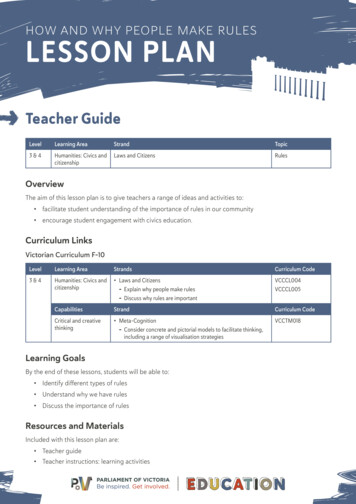
![[Page 1 – front cover] [Show cover CLEAN GET- AWAY 978-1 .](/img/13/9781984892973-6648.jpg)

